|
|
|
|||
|
|
||||
|
|
||||
| Smoke Trails | ||||
|
|
HOME | SITE MAP | FORUM | CONTACT |
|
||
|
ABOUT | MOTORS | MODELS | ARCHIVE | HISTORY | STORE | FAQ | LINKS
|
|
|
|
|
|
||||||||||||||||||||||||||||||||||||||||||||||||||||||||||||||||||||||||||||||||||||||||||||||||||||||||||||||||||||||||||||||||||||||||
|
Smoke Trails 15
(March 2008)
by Roger Simmonds Adapted from a column originally published in SAM 35 Speaks, March 2008 Carl Godel Memorial Contest Despite the concerns aired in my last article, this event was judged a great success by those who attended, and by Steve Bage and Howard Metcalfe, who had sent entries by proxy. However, Dennis Kolartis, our other European proxy contestant, was definitely not happy – his potent but delicate model was crushed en route. A US Post Office sticker baldly stated: ‘Package arrived without contents’ [!?]. Most odd – perhaps they thought the curious arrangement of balsa wood and tissue was just packing. Or is there a more sinister explanation – was this an attempt to sabotage the European challenge? If so, they failed. As to who ‘they’ might be, to quote Inspector Clouseau: “I suspect nobody, I suspect everybody”. Here are the results: |
|
||||||||||||||||||||||||||||||||||||||||||||||||||||||||||||||||||||||||||||||||||||||||||||||||||||||||||||||||||||||||||||||||||||||||

- Complied by Ben Nead
Steve’s win was not wholly unexpected, and Howard missed second place by only a gnat’s whisker (or a Rapier splutter). These results may be as big a blow to the assumed US hegemony in all things rocketry as the first Sputnik. Questions will be asked in Congress. As to the contest itself, Ben, the organiser, writes: “We were all very disappointed to see that the winds (NOT predicted) were rather intense when we arrived on the field [the previous practice day had been a perfect calm]. By around 11am, though, it had calmed down considerably and conditions were near perfect with temperatures in the mid to upper 60s. Save for a quick lunch break, it was pretty much non-stop flying throughout the afternoon. |
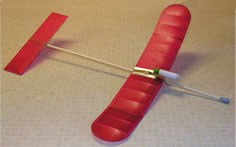 Steve Bage’s winning Snowflake II for Rapier L1
- Steve Bage
|
||||||||||||||||||||||||||||||||||||||||||||||||||||||||||||||||||||||||||||||||||||||||||||||||||||||||||||||||||||||||||||||||||||||||
|
|
|
|||
|
“There had been much speculation as to how our motors would behave, but [in the event] the current batch of L-1s is very good. Nozzles seemed relatively straight – all were checked by inserting a #63 drill blank inserted into the nozzle, rolling on a flat surface and any eccentricity [of the drill, not the contestant] noted. Casings were marked on the ‘crooked’ side and this was always oriented in the model to exaggerate any built-in down thrust. Out of about the 60+ motors fired, we had around 4 or 5 ‘pop and stop’ incidents, but no cases of burn-through.” Ben comments about the mandatory electronic igniters: “Who cares if the new Rapier fuses are not as good as the old ones – fuses are dead, long live the electronic igniter!” |
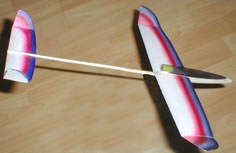 Howard Metcalfe's QT for Rapier L-1
- Howard Metcalfe
|
|||
|
A little needs to be said about the ‘modern’ models: Howard’s QT (above right), Shorty’s Contender and Ben’s Sweepette-toot (right) are ‘solids’ with a configuration similar to a chuck or catapult glider. Motors are mounted on pylons just forward of the CG (see illustration). Howard’s all-Depron QT, and especially its derivatives, remind me of the old Jetex Sharky or Wren on steroids. What is really gratifying is that of two of the three ‘vintage’ models appear in the first four, and the Arrow 50 (Ian Dowsett’s classic design) just needed a little more tweaking to be competitive. Steve Bage modestly comments that there was really very little between the first three and he “got lucky and caught a thermal with his first flight”. Those of us who have seen his Snowflake II in action would venture to disagree. The Arrow 50, Snowflake and Monsieur Maillard’s Pfufp (note spelling) have featured before in these columns. |
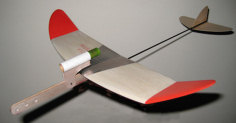 Ben Nead's Sweepette-toot for Rapier L-1
- Ben Nead
|
|||
|
Rick feared his Pfufps would be “hard to tame at that size and weight”. And so it proved. Ben writes: “Rick's Pfupfs were wildly inconsistent. He had two apparently identical examples that were both light and expertly crafted. One was destined to fly away forever every time it was launched … the other one would dive into the dirt 10 feet in front of you as if carved from solid oak, even though it seemed to have all the pre-flight attributes of its brother. The better Pfufp fascinated everyone – it moved around in the air like a possessed bumblebee with the motor running, but turned into a championship soarer after the fuel expired. On its first test flight Saturday afternoon it flew out-of-sight and we lost track of it after about 10 minutes. “It was only some hours later that someone on a chase bike found it whilst retrieving another plane. Rick’s scores represent a combination of times recorded by both planes, with the better one flying OOS. Though we eventually got the other one properly airborne, it never really excelled. |

- Rick Carnrick
Deux petits Pfufps pour L1 – the one à droite is the good one. The oddly named Pfufp was designed in 1951. ‘Pfufp’ is, apparently how Jetex exhaust sounds to Gallic ears – try it with a French accent! Like the Arrow 50, the motor is underslung, not pylon mounted. Rick Carnrick reduced the span of his pair to 11" for L1. Even with nose-weight they weigh a mere 6 grams sans moteur. Graham Knight has produced a version for Rapier L2. |
|||
|
“Caley Hand’s Arrow 50 [top right] flew like a milder version of Rick's better Pfufp; it would loop, circle and bump around on the way up and then turn into a feather when gliding. It required very careful trimming, and moving the rubber-banded wing one way or another on the pylon had a dramatic effect on the flight profile. But it was genuinely capable of good flights.” Caley says of only her second rocket-propelled model: “It was actually fairly easy to build, once I got into it. The fuselage is “It was built ‘full size’ – I guess it's possible to reduce it by about 10%, though I don't know what the effect on performance would be. I found the flying surfaces were warped when I got to Eloy, and though it flew about eight times, it never put in anything as good as the other models and my best flight was only [?] 40 seconds, but it didn't crash and I was elated.” I discussed the Arrow 50 in (Jet)X Files 4, but Caley’s is the first Rapier-powered one I’ve seen. It is encouraging that it flew well with less than half the thrust it was designed for. Exchanging the L1 for an L2 should release the model’s potential – once the warps, which can be a chronic problem with these lightweight designs, have been sorted out. Having digested Ben’s report, Steve, our worthy British winner, sums up: “It's hard to draw any firm conclusions as to what the 'ultimate' Rapier L1 duration design is, as, clearly, different approaches are capable of producing competitive models. Small light models tend to have a lively performance that can produce a ballistic climb, but they tend to be hard to trim and are unpredictable. Larger but still light models (like the Snowflake) have decent climb, and the low wing loading means they should float in the glide, but their size means drag and they don’t have the stellar climb rate that, say, Howard’s QT is capable of. Larger, slightly heavier models are easier to trim and are the most predictable and consistent, but their performance is ultimately limited. I'm already thinking about my next model. I may try a swept wing tailless design inspired by the BV P215 but without any fuselage. One of the great things about these little duration models is that they take no time to build so it's no problem to try a few alternative designs and see what works best.” I have three of comments on all of the above. First, though the L1 motors were better behaved than expected, and delivered a reproducible thrust of 70 mN or so, 4-5 motor failures out of sixty firings is still a somewhat worrying statistic. Second, though I quite like fuses (they are so Jetex-like), it is obviously time to invest in an electronic igniter. And third – yes, I know, the event at Eloy cannot be compared with the Jetex events of yore. But it’s a start and we can certainly plan a similar one in the UK. As Eloy shows, vintage designs can compete with the best; it would be great to see the sky above Middle Wallop full of Snowflakes, Arrows, Twizzlers, Stilletos, Fizzlesticks and the odd Spook or two. And then there's John O’Donnell’s only published Jetex plan, the formidable (32" wingspan) Castaway, for the Scorpion 600. The Synjet and the genesis of the Rapier |

- Caley Hand
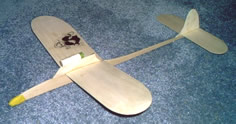
- Carole Kane
Two contrasting contenders at Eloy Top: Caley’s Arrow 50 – originally designed for Jetex 50, it nevertheless put in a creditable performance powered only by an L1. Below: Shorty’s Contemporary Contender – this simple but effective design is now available as a kit from Shorty’s Basement in the US |
|||
As I reported in Smoke Trails 13, relatively little was known in the West about the Synjet. Ruja Zdravi has now kindly translated an article by Otakar Saffek that was originally published in Modelar, a Czechoslovakian aeromodelling magazine, in May 1992. It’s called ‘The Renaissance of S-2 Motors’, and makes for very interesting reading. So here, for the first time in English, is some proper gen about these Eastern European analogues of Jetex. The illustrations (right and below, with apologies for the degraded photo) are from the article.
- Modelar, May 1992
Synjet motors: (left to right) S-4, S-3, S-2 original, S-2 new type, S-1 super (prolonged), S-1 prolonged with cooling fins, S-1, S-mini.Synjets were the creation of a Mr Machacek, the author of the patent, and Frantisek Rumler, who was responsible for manufacture of the motors and accessories. Ruja adds in a footnote that under Communism all goods with explosive potential were prohibited from free sale, so it had not been easy to get approval; the motors first appeared in the shops in 1963 only after several years’ testing, and the propellant pellets were available only from the Svarzarm, a semi-military organisation to which all model clubs had to belong. There were eight motors of a basic design so similar to Jetex (see diagram above) that one wonders how they got around the Wilmot Mansour patents. The article does not, alas, include any specifications for the original range of motors, nor is the composition of the propellant given, though we are told that combustion temperatures were "significantly higher than Jetex". However, the S-2 appears closest to the Jetex 50 or Atom 35, and quickly became popular due to its low cost and reliability. The first plan, for a simple glider, appeared in Modelar, September 1963, and this was soon followed a semi-scale Hunter. Balsa could be in short supply at that time, but this only seemed a spur to modellers’ creativity and an impressive variety of models, including helicopters, canards, flying wings, rogallos, and even flying boats, was built. There were also scale jets with enclosed motors and a “duct of fireproof material”. Manufacture of the motors ceased around 1977. Mr Saffek does not discuss any kits, which we know Synjet also produced, or whether any of the plans for canards, flying wings, rogallos etc were still available in Modelar’s ‘X list’ (if there was one). More research is needed! The ‘Renaissance’ in the article’s title refers to the activities of a group of lucky rocketeers who unearthed stocks of propellant when the Svarzam was disbanded in 1989, and the efforts of a Mr Rambousek to remanufacture the motors. As the article wryly observes, “However, the problem is the fuel pellets”. Now where have we heard that before? But a viable propellant was apparently developed and tested by a Mr Svejka of the Paradubice Model Rocket Club; an S-2 with the new pellets gave a thrust of 100mN for 14-18 sec. It is interesting that there was a similar revival of Jetex activities in the UK when Powermax unearthed stocks of 50HT motors and pellets and kept the flame burning, albeit fitfully, until the arrival of Rapiers. Incidentally, Ruja records ruefully that Modelar, a very popular flying magazine published for more than forty years, is now “devoted to plastic kits”. |
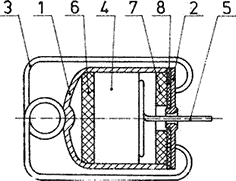
- Modelar, May 1992
1. Combustion chamber. 2. Nozzle cap.3. Safety clip. 4. Propellant tablet. 5. Plastic fuse. 6-8. Seals. |
|||
|
I suspect Mr Rambousek’s and Svejka’s long-term plans were not commercially viable. However, the demise of Synjets had at least one happy outcome, as, just a few years later, there was a vacant niche in the market that Dr Jan Zigmund (right) – who also comes from Pardubice – could exploit. The edited extracts below, which relate to the development of Rapiers, are taken from Ruja and his colleagues’ extensive interview with Dr Z that can be found (in English translation) at www.minimakety.cz. First, Dr Z reminices about his early modelling experience: “I used to build models when I was a kid. I was fascinated by Synjet motors and built semiscale profile models – I remember one flight when the motor ran perfectly and the model flew just like the real thing. I stopped building the models when the motors came off the market in the 70s. I also built model rockets, and during my studies at military high school in 1973 I attended a course for model rocket instructors”. Asked about the inspiration for Rapiers, Dr Z said he had wanted to buy his son a radio-controlled helicopter, but these were too expensive. To mitgate his son’s disappointment, he told him about Synjets and of planes made of balsa. He promised that he would try to develop a safe motor for recreational flying with low thrust and a long period of burning that would propel the model aeroplane to a height of 20-30m, from where it would glide back to ground. Dr Z adds that he has a degree in chemistry with a specialisation in the theory and technology of explosives and high power propellants. Readers will recall that Pardubice is famous, or infamous, for the production of Semtex. Dr Z did most of the R&D in in 1997, when he had “an unimaginable three months of free time following a minor injury”. The company was registered in 1998. From the beginning, Dr Z considered that commercially available paper tubes with a ceramic endcap and nozzle would be adequate for the temperatures and pressures envisioned: “This eliminates the high cost of metal motors of the Jetex and Synjet type. A metal motor would cost hundreds of CZK today, but the expensive technology of drawing or turning duralumin motor chambers, jets, washers etc. is omitted”. There is also, of course, no need to mould the pellets. |

- Adam Jenik, June 2005
|
|||
|
Dr Z also thought that black powder would be an viable propellant. However, this was not so and he developed “a mixture based on ammonium perchlorate and zinc. The chemical composition was selected to achieve a very low oxygen balance and therefore a low combustion temperature; a proportion of the zinc sublimes and removes heat from the motor. During the first attempts, it surprisingly worked for over 10 seconds”. Thus the basic design of the Rapier motor was quickly arrived at, Dr Z claiming, “[The] low-thrust. long-duration rocket motor with ceramic (clay) nozzles for model airplanes is considered to be an invention [and] I’m the only originator of this idea”. The originator then needed to test his invention: “I made the first model at the end of March 1998. After a 30 year break in modeling, I of course had lost my skills, and the first model was a bit funny. It was an L-159 made of three balsa sheets with irregular areas of red green and black camouflage made with marker pens I found somewhere. The motor bracket was made of wire. We mixed propellant and packed 5 motors for the first flights. We went to the meadow over the village, prepared the model, lit up the motor and hand launched. The motor fell off and burned up in the grass.” The second and third attempts followed a similar pattern, but after some adjustments to the motor brackets with pliers, Dr Z says of the next flight, “The L-159 hung around, it did not really fly, and landed on the ground. Afterwards I put trim tabs made of adhesive tape on the rudder, stabilizer and wing tips, test glided it first, lit up the motor and launched. The model made three beautiful loops, gaining a height of about 15m, where it straightened into a glide and finally made a great landing. We stood there with our mouths open: WoooooooooooW! So the first flight test was successful and that propellant is still used.” Dr Zigmund’s story of the first test flights is curiously reminiscent of Joe Mansour’s and Alex Hutchinson’s legendary exploits in Ardeer, now more than sixty years ago. The full transcript has a lot more in this vein. It also includes some simple performance graphs: 
- Dr Jan Zigmund
Above: L-2. This may be an early example as the thrust is ‘only’ 100 mN, but for 20 sec.
- Dr Jan Zigmund
Above: L-2HP. The thust, about twice that of the L2, appears more variable. 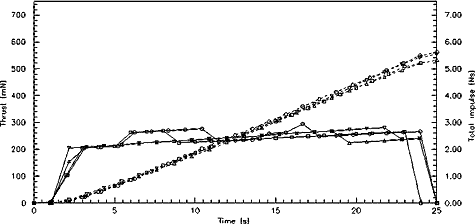
- Dr Jan Zigmund
Above: An early example of L-3 measured on a simple letter scale, with adjustments made for the diminishing weight of the motor. The 200-300mN thrust is rather less than a Jetex 100. Contest Kits Squib |

- Terry Kidd
|
|||
|
This comparatively unknown duration model of uncertain provenance is nevertheless well worth considering for any future ‘Carlo Godel type’ event. According to the Contest KIts advertisement (below right), it gained second place in the S.M.A.E. Jetex Trophy contest of 1955, while the box top (right) claims an average duration of two minutes. Replikit apparently had plans to resurrect it following its appearance on eBay not long ago. Unfortunately, these have come to nothing. However, the plan is available from Pete’s Plans, and Tom Ready and Andy Blackwell (who paid £15 for a mint kit at a swapmeet), can provide scans of printwood. Tom, optimistically, hopes to power his Squib (right) with a Jet X-50. The kit was actually manufactured by E. Keil & Co., but neither the designer nor the date are specified on the (rather rudimentary) plan (below). It is a well-proportioned design (12" span by 13" long), but the motor is top-mounted quite forward of the CG without a pylon, so some modification for Rapier will be required. A 10% reduction for L-1 would be about right, unless it’s built very light. But be warned: Tom says choose very hard/strong wood for the fuselage as his broke very easily. The double sparred wing should be quite warp resistant, if not totally immune from the tender mercies of Post Office (or CIA) operatives! 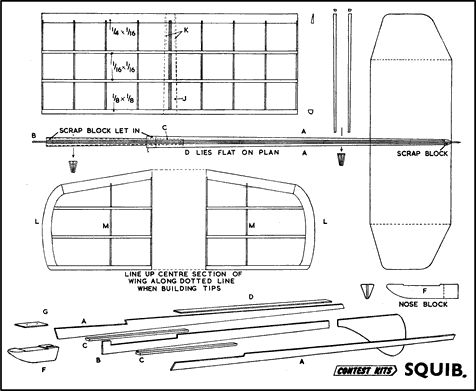
- Contest Kits
|
 Contest Kits Squib, constructed by Tom Ready
- Tom Ready
 Contest Kits Squib box top
- Andy Blackwell
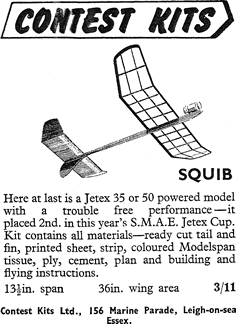 Contest Kits advertisement, showing Squib with top-mounted Jetex motor forward of the wing
- Aeromodeller, August 1955
|
|||
|
|
||||
|
|
|
|||
|
|
|
|
|
|
|
|
Acknowledgements - Article: Roger Simmonds - Illustrations: Roger Simmonds, Steve Bage, Andy Blackwell, Rick Carnrick, Caley Hand, Adam Jenik, Terry Kidd, Carole Kane, MAAC archives via Bill Henderson, Howard Metcalfe, Ben Nead, Tom Ready, Ruja Zdravi |
|
|
|
|
ABOUT | MOTORS | MODELS | ARCHIVE | HISTORY | STORE | FAQ | LINKS |
|
|
Terms of Use
|
Queries? Corrections? Additions?
Please
contact us.
|
|